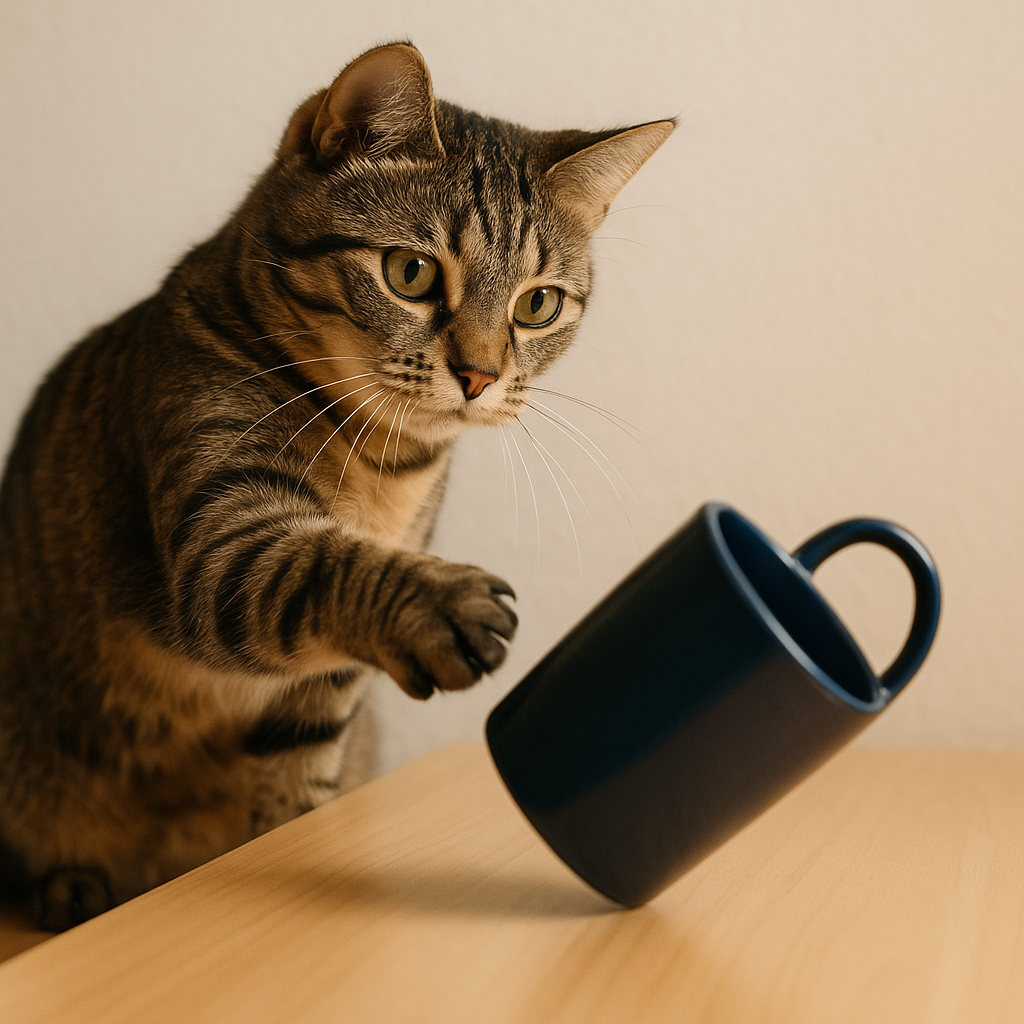Meta Description: Discover why cats knock things off tables and counters! Learn the science behind this frustrating behavior and proven strategies to redirect your cat’s natural instincts.
Picture this: you’re working at your desk when your cat casually strolls over, makes direct eye contact, and deliberately pushes your pen off the table while maintaining that innocent “What? Me?” expression. If you’re a cat owner, this scenario is probably all too familiar. The infamous cat behavior of knocking things over has frustrated pet parents for generations while simultaneously providing endless entertainment for internet memes.
But what drives this seemingly spiteful behavior? Is your cat actually trying to annoy you, or is there a deeper biological and psychological explanation for their persistent item-pushing antics? Understanding the root causes behind this behavior not only helps reduce frustration but also provides insights into your cat’s natural instincts, communication methods, and environmental needs.
From hunting instincts and attention-seeking behaviors to boredom and territorial marking, there are multiple reasons why cats engage in this maddening yet fascinating behavior. By exploring the science behind why cats knock things over and learning proven management strategies, you can transform this frustrating habit into an opportunity for better understanding and communication with your feline friend.
The Science Behind the Swat: Understanding Feline Instincts
To truly understand why cats knock things over, we need to explore the evolutionary and biological drivers that make this behavior so irresistibly appealing to our feline companions.
Hunting Instincts: The Predatory Drive
At the core of most item-knocking behavior lies your cat’s powerful hunting instinct. Even the most pampered house cat retains the same predatory drives that helped their ancestors survive in the wild.
Testing Prey Response: When cats encounter objects, especially small items that might move or roll when touched, their predatory instincts kick in. The initial paw swat serves as a test to determine whether the object is prey, predator, or simply an inanimate obstacle.
Movement Triggers: Objects that roll, slide, or make noise when touched provide immediate feedback that mimics wounded or fleeing prey. This feedback loop reinforces the behavior and makes it more likely to be repeated.

Practice Hunting Skills: Indoor cats often lack adequate opportunities to practice their natural hunting behaviors. Knocking objects around serves as a substitute hunting activity that allows them to exercise these hardwired instincts.
Paw Sensitivity and Exploration
Cats use their paws as sophisticated sensory tools for exploring and understanding their environment.
Tactile Investigation: Cat paws contain numerous nerve endings that provide detailed information about texture, temperature, weight, and movement. Batting at objects allows cats to gather comprehensive sensory data about items in their territory.
Testing Object Properties: By pushing objects, cats learn whether items are stable, moveable, breakable, or potentially dangerous. This information helps them navigate their environment more effectively.
Curiosity Satisfaction: Cats are naturally curious creatures who need to investigate anything new or interesting in their environment. Knocking things around is often simply a thorough investigation technique.
Attention-Seeking Behavior: The Psychology of Cat Communication
Many cats quickly learn that knocking things over is an extremely effective way to capture human attention, even if that attention is negative.
The Reinforcement Cycle
Immediate Response: When cats knock something over, humans typically respond immediately with attention, whether it’s scolding, chasing the cat away, or simply looking at them. From the cat’s perspective, mission accomplished – they’ve successfully engaged their human.
Negative Attention vs. No Attention: Cats don’t distinguish between positive and negative attention the way humans do. Any response, including frustrated exclamations or being chased, can reinforce the behavior.
Learned Timing: Smart cats often learn exactly when this behavior will be most effective, such as when you’re working, eating, or trying to sleep. The more inconvenient the timing, the stronger your response is likely to be.
Communication Attempts
“Pay Attention to Me” Message: Cats may knock things over when they want interaction, play time, food, or simply acknowledgment from their humans.
Routine Disruption Signals: Some cats use object-knocking to communicate that something in their routine has changed or that they’re dissatisfied with their current situation.
Territory Reminders: By moving objects around, cats may be reminding you that this is their space too and that they have opinions about object placement.

Boredom and Under-Stimulation: The Energy Outlet
Cats are intelligent, active creatures who need mental and physical stimulation to remain happy and well-behaved. When these needs aren’t met, destructive or annoying behaviors often emerge.
Mental Stimulation Needs
Intelligence Without Outlets: Cats are problem-solvers who need mental challenges. Without appropriate puzzles, games, or exploration opportunities, they create their own entertainment by manipulating objects in their environment.
Novelty Seeking: Cats crave new experiences and stimulation. Knocking over the same pen repeatedly might seem boring to us, but each interaction provides slightly different sensory feedback for the cat.
Environmental Enrichment Deficits: Indoor cats may lack sufficient environmental complexity to keep their minds engaged, leading them to find creative ways to make their surroundings more interesting.
Physical Activity Requirements
Energy Release: Cats need regular physical activity to maintain health and behavioral balance. Knocking things around can serve as a form of exercise, especially for less active or older cats.
Play Substitution: Without adequate interactive play sessions, cats may use household objects as substitute toys to meet their activity needs.
Hunting Practice: In the absence of real prey, cats practice their hunting skills on whatever moving objects are available – including items they can make move by knocking them around.
Territorial Behavior: Claiming and Organizing Space
Cats are territorial creatures who have strong opinions about how their environment should be organized and maintained.
Scent Marking Through Touch
Pheromone Distribution: Cat paws contain scent glands that deposit pheromones on objects they touch. Knocking things around spreads their scent throughout the territory, creating a familiar and comforting environment.
Territorial Boundaries: By moving objects, cats may be establishing or reinforcing territorial boundaries within their home environment.
Ownership Claims: Pushing your belongings around might be your cat’s way of mixing scents and claiming shared ownership of objects and spaces.

Environmental Control
Object Placement Preferences: Cats often have strong preferences about where things should be located in their territory. Knocking items off “wrong” surfaces might be their way of reorganizing according to their preferences.
Surface Claiming: Tables, counters, and other elevated surfaces are prime real estate in cat territory. Clearing these surfaces of human objects may be a way of claiming the space for cat use.
Routine Maintenance: Some cats seem to “patrol” their territory regularly, investigating and potentially moving objects that have changed position since their last inspection.
Age and Health Factors
Sometimes, object-knocking behavior changes or intensifies due to age-related or health-related factors that affect your cat’s behavior and needs.
Kitten and Young Cat Behavior
Developmental Play: Kittens and young cats are naturally more active and exploratory. Object-knocking is often part of normal developmental play behavior that helps them learn about their environment.
Energy Levels: Young cats have abundant energy that needs outlets. Without sufficient appropriate activities, this energy often gets channeled into mischievous behaviors.
Learning Boundaries: Young cats are still learning household rules and may not yet understand which objects are acceptable to play with.
Senior Cat Considerations
Sensory Changes: Older cats may experience changes in vision, hearing, or touch sensitivity that affect how they interact with objects. They might knock things over more frequently due to decreased coordination or awareness.
Cognitive Changes: Some senior cats experience cognitive changes that can affect behavior patterns, including increased confusion or changes in established routines.
Comfort Seeking: Older cats may knock things over to create more comfortable spaces or to access warm, sunny spots that were previously occupied by objects.
Health-Related Factors
Vision Problems: Cats with developing vision issues may bump into or knock over objects more frequently as they navigate familiar spaces.
Pain or Discomfort: Cats experiencing pain might change their movement patterns, leading to increased clumsiness or different approaches to navigating their environment.
Stress-Related Behaviors: Health issues often create stress, which can manifest as increased destructive or attention-seeking behaviors, including object-knocking.
Environmental and Situational Triggers
Certain environmental factors and situations can increase the likelihood of object-knocking behavior.
Object Characteristics
Size and Weight: Small, lightweight objects that move easily when touched are most likely to be knocked around. Items like pens, small decorative objects, and lightweight containers are prime targets.
Texture and Material: Objects with interesting textures, temperatures, or materials may attract more attention and manipulation than plain or familiar items.
Movement Potential: Items that roll, slide, or make noise when pushed provide immediate feedback that reinforces the knocking behavior.
Location Factors
High Traffic Areas: Objects placed in areas where cats frequently walk or spend time are more likely to be investigated and potentially knocked over.
Elevated Surfaces: Cats naturally prefer elevated positions, and objects on tables, counters, or shelves are easily accessible for exploration and manipulation.
Territory Boundaries: Items placed near feeding areas, litter boxes, or favorite sleeping spots may be moved as part of territorial organization behavior.
Proven Strategies to Manage Object-Knocking Behavior
Understanding why cats knock things over is the first step toward managing this behavior effectively. Here are practical strategies that address the underlying motivations while protecting your belongings.
Environmental Modifications
Secure Important Items: Place valuable or dangerous objects in closed drawers, cabinets, or other cat-proof storage areas. Prevention is often more effective than correction.
Create Cat-Friendly Surfaces: Designate certain elevated surfaces as “cat spaces” where they can climb, rest, and investigate without interfering with your belongings.
Use Deterrents Strategically: Double-sided tape, aluminum foil, or motion-activated air sprays can make certain surfaces less appealing for exploration without harming your cat.
Provide Alternative Outlets: Offer appropriate objects for investigation and manipulation, such as cat-safe toys, puzzle feeders, or items specifically designated for cat play.
Enrichment and Stimulation
Increase Interactive Play: Schedule 10-15 minutes of active play sessions twice daily using wand toys, laser pointers, or other interactive toys that satisfy hunting instincts.
Rotate Toys Regularly: Keep toys interesting by rotating them weekly and introducing new textures, sounds, and movements.
Environmental Complexity: Add cat trees, climbing shelves, hiding spots, and various levels to create a more stimulating environment that meets exploration needs.
Food Puzzles and Feeders: Use puzzle feeders, treat-dispensing toys, and hidden food placement to provide mental stimulation during meal times.
Attention and Response Management
Ignore Attention-Seeking Behavior: When cats knock things over for attention, avoid giving them the response they’re seeking. Instead, calmly clean up and redirect them to appropriate activities.
Provide Positive Attention: Increase positive interactions with your cat during times when they’re behaving well, reducing their need to seek attention through mischievous behavior.
Consistent Responses: Ensure all family members respond to object-knocking behavior in the same way to avoid confusing mixed messages.
Timing Interventions: Redirect your cat to appropriate activities before they have a chance to knock things over, rather than only responding after the behavior occurs.

Training and Redirection
Clicker Training: Use positive reinforcement training to teach alternative behaviors and reward your cat for leaving objects alone.
Command Training: Teach simple commands like “leave it” or “off” using treats and positive reinforcement to redirect behavior when needed.
Scheduled Interaction: Establish regular times for focused attention and play, reducing your cat’s need to demand attention through destructive behavior.
Activity Scheduling: Plan active play sessions before times when you need to focus on work or other activities, helping tire out your cat preemptively.
When to Seek Professional Help
While most object-knocking behavior is normal and manageable, certain situations may benefit from professional intervention.
Veterinary Consultation
Sudden Behavior Changes: If your cat suddenly starts knocking things over much more frequently, or if the behavior is accompanied by other changes in appetite, energy, or bathroom habits, consult your veterinarian.
Senior Cat Changes: Increased clumsiness or changes in coordination in older cats should be evaluated for underlying health issues.
Destructive Escalation: If the behavior becomes destructive enough to cause significant damage or safety concerns, professional guidance may be needed.
Behavioral Consultation
Persistent Problems: If management strategies haven’t reduced the behavior after several weeks of consistent application, a certified cat behaviorist may provide additional insights.
Multiple Behavioral Issues: Cats displaying several problematic behaviors simultaneously may benefit from comprehensive behavioral assessment and modification plans.
Stress-Related Factors: If object-knocking appears to be related to stress, anxiety, or environmental changes, professional guidance can help address underlying causes.
Frequently Asked Questions About Cat Object-Knocking Behavior
Q: Is my cat knocking things over out of spite or revenge?
A: No, cats don’t act out of spite or revenge. This behavior is driven by natural instincts, communication attempts, boredom, or attention-seeking. Cats live in the moment and don’t plot revenge for past events.
Q: Will my cat eventually outgrow this behavior?
A: Many cats do reduce object-knocking behavior as they mature and their play needs are better met, but some adult cats continue this behavior throughout their lives. Management strategies are usually more effective than simply waiting.
Q: Should I punish my cat for knocking things over?
A: Punishment is generally ineffective and can damage your relationship with your cat. Focus on prevention, environmental management, and providing appropriate outlets for natural behaviors instead.
Q: Why does my cat maintain eye contact while knocking things over?
A: The eye contact often indicates attention-seeking behavior. Your cat has learned that this action gets a response from you and is essentially “asking” for interaction, even if it’s negative attention.
Q: Can I train my cat to stop knocking things over completely?
A: While you can significantly reduce the behavior through management and training, completely eliminating it may be unrealistic since it stems from natural feline instincts. Focus on redirecting the behavior to appropriate outlets.
Conclusion: Understanding and Managing Your Cat’s Natural Behaviors
The mystery of why cats knock things over reveals fascinating insights into feline psychology, natural instincts, and communication methods. Rather than viewing this behavior as purely mischievous or spiteful, understanding the underlying motivations helps us respond more effectively and compassionately to our cats’ needs.
From hunting instincts and sensory exploration to attention-seeking and territorial behaviors, object-knocking serves multiple purposes in your cat’s behavioral repertoire. By recognizing these motivations and implementing appropriate management strategies, you can reduce frustrating incidents while strengthening your bond with your feline companion.
Remember that completely eliminating this behavior may be neither realistic nor necessary. Instead, focus on channeling your cat’s natural instincts into appropriate outlets while protecting your important belongings through environmental management and increased enrichment opportunities.
The key to success lies in consistency, patience, and understanding that your cat isn’t trying to annoy you – they’re simply being a cat. By working with their natural behaviors rather than against them, you can create a harmonious household that meets both your needs and your cat’s instinctual drives.
Every knocked-over pen or pushed-off trinket is an opportunity to better understand your cat’s world and strengthen your relationship through appropriate responses and increased enrichment. Embrace the challenge, implement the strategies, and enjoy the process of learning to communicate more effectively with your fascinating feline friend.
What creative solutions have you found for managing your cat’s object-knocking behavior? Share your success stories and tips in the comments below!
Ready to redirect your cat’s mischievous energy? Check out our recommendations for interactive toys, environmental enrichment products, and training tools that satisfy natural instincts while protecting your belongings.
Related Articles You Might Enjoy:
- “15 Funniest Cat Behaviors Explained”
- “Understanding Cat Body Language: What Your Cat Is Really Telling You”
- “The Mystery of Cat Whiskers: What They Really Do”
- “Common Health Problems in Cats (and Prevention Tips)”
Keywords: why cats knock things over, cat behavior, cat knocks things off table, feline behavior problems, cat mischief, attention seeking cats, cat hunting instincts, cat behavioral issues, understanding cats

